Consumers tend to prioritize convenience above everything else. That is why offering alternative contact methods like “request a callback” forms can enhance user experience and boost lead capture.
By integrating a well-designed ‘request a callback’ form on your WordPress website, you give visitors the option to conveniently request a call at their preferred time. This not only improves conversion rates by catering to those who prefer phone communication but also allows you to capture valuable leads for future sales opportunities.
In this article, we will show you how to easily add a request to callback form in WordPress. We will even provide bonus tips on managing callback requests to ensure a smooth and positive experience for both you and your potential customers.
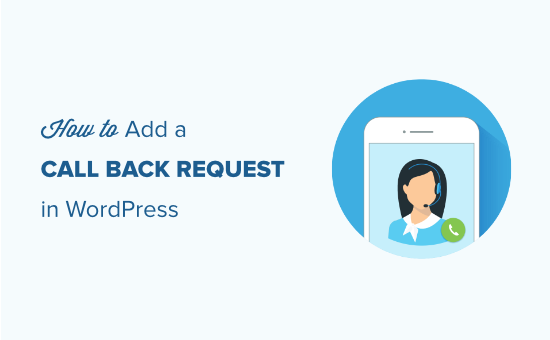
Why Add a Callback Request Form in WordPress?
Visitors interested in your product or service may want to connect with you for more information. While some people prefer live chat or email, others prefer talking over the phone.
You can add a ‘Click to call‘ button on your WordPress website that allows users to dial your business phone number.

However, not all small businesses can afford a 24/7 phone service with sales or support staff answering all the calls. A request to callback form helps you fix this problem.
Instead of talking to a representative right away, customers can leave their phone numbers with other information, including the best time to call them, by submitting a form. After that, you can call them during office hours.
This allows you to offer better customer support, capture more leads, and convert more visitors into customers.
That being said, let’s take a look at how to easily add a callback request form in WordPress. You can use the quick links below to jump to different sections of our tutorial:
How to Add a Request to Callback Form in WordPress
The simplest way to add a callback request form to your WordPress site is by using WPForms.
It is the best WordPress form builder plugin on the market that allows you to easily add any kind of form to your WordPress website. Over 6 million websites are using WPForms to create better forms.
First, you need to install and activate the WPForms plugin. For more details, see our step-by-step guide on how to install a WordPress plugin.
Note: If you are on a budget, then you can use WPForms Lite, which is completely free to create a request to callback form. However, you will need the premium version of the tool to access the Phone form field.
Upon activation, visit the WPForms » Settings page to enter your license key.
You can find this information in your account on the WPForms website.
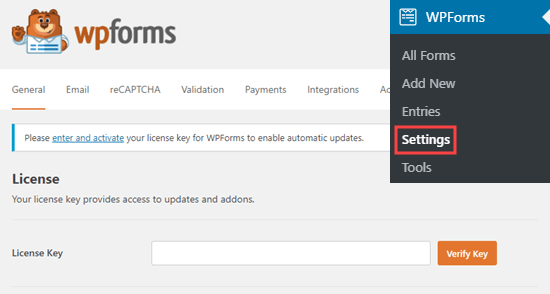
Once you have done that, head over to the WPForms » Add New page from the WordPress admin sidebar.
This will direct you to the ‘Select a Template’ page, where you can start by typing a name for the form.
After that, you have to select the ‘Simple Contact Form’ template to start building your request to callback form.
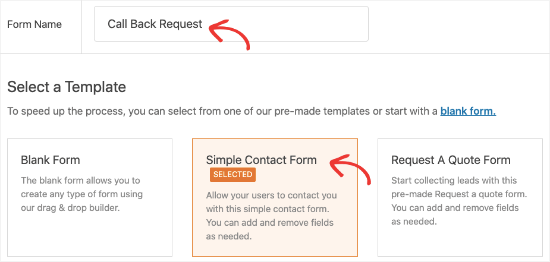
This will launch the WPForms form builder, where you will see form fields in the left column and a live preview of your form to the right.
From here, you can simply drag and drop any field you want from the left column to add it to your form.
We suggest using the Name, Email, Phone, and Date/Time fields in your callback request form.
This way, you will be able to collect all the important information needed to contact a user.
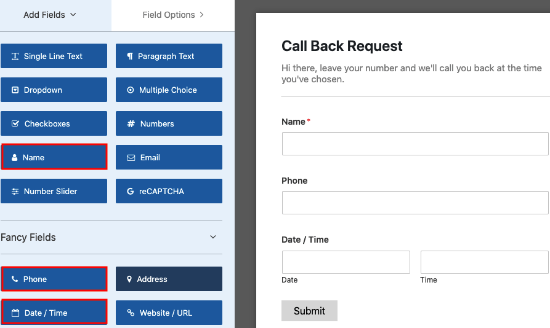
Once you have added all the form fields of your choice, you can also edit them by clicking on the fields.
This will open up the ‘Field Options’ tab in the left column of the screen.
From here, you can change the field label and description. You can also change the format, field size, and placeholder text.
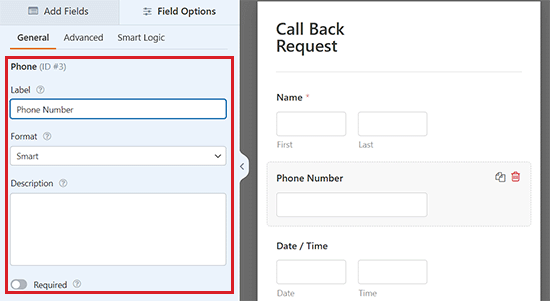
You can even toggle the ‘Required’ switch in the column to active so that users won’t be able to submit a form without filling in that specific field.
Once you are done, don’t forget to click the ‘Save’ button at the top to store your form settings.
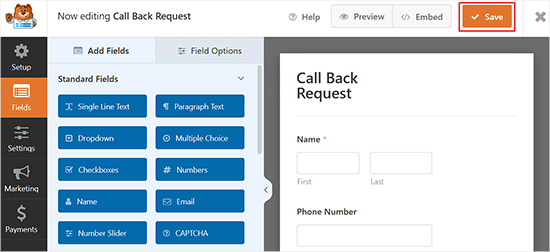
Next, you need to add the callback request form to your WordPress blog.
WPForms makes it super easy to add forms to any WordPress page or post on your website. First, you need to open an existing or new page/post from the WordPress admin sidebar.
Once you are there, click the ‘Add Block’ (+) button at the top left corner of the screen to open up the block menu.
From here, locate and add the WPForms block into the block editor.
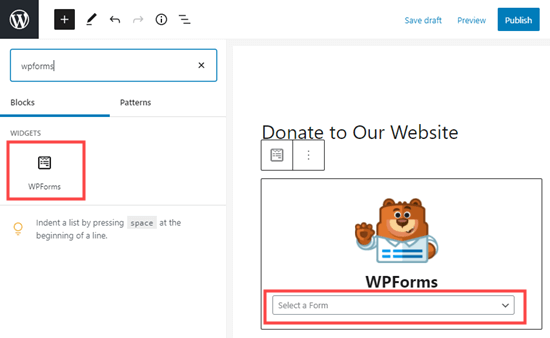
Next, you must select the form you created earlier from the dropdown menu. WPForms will now automatically load a preview of your form in the content area.
Finally, click the ‘Update’ or ‘Publish’ button to store your settings.
Note: If you are using the old classic editor on your WordPress site, then you can add the form by clicking on the ‘Add Form’ button above the post editor.
This will open up the ‘Insert Form’ prompt, where you can choose a form to add from the dropdown menu.
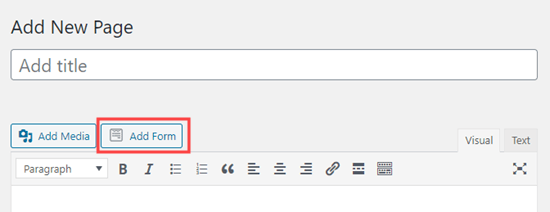
Once you are done, don’t forget to click the ‘Update’ or ‘Publish’ button to store your settings.
Now, you can visit your WordPress website to view your request to a callback form in action.
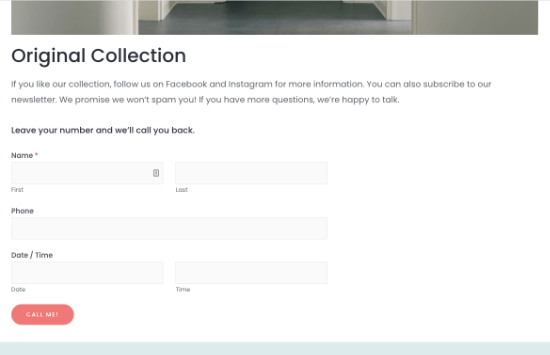
Customizing Your Callback Request Form Settings
Now that you have added a callback request form to your site, you can edit it at any time and customize it to fit your needs.
To do this, simply visit the WPForms » All Forms page from the WordPress dashboard and click on the ‘Edit’ link under the form you created earlier.
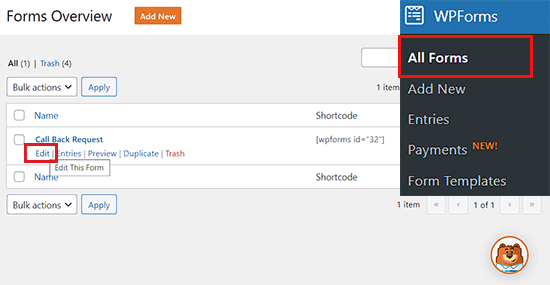
This opens the form builder interface, where you can edit your form, add or remove fields, change labels, and more.
You can now switch to the ‘Settings’ tab from the left column. From here, you can change your form settings, such as form name, description, button label, notifications, and more.
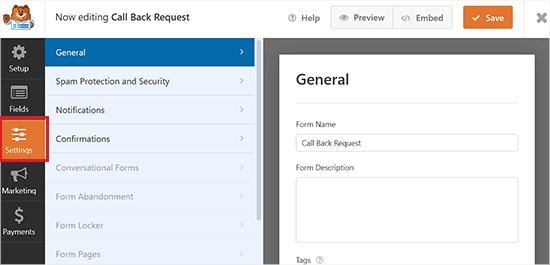
Configure Notifications for Request to Callback Form
By default, WPForms uses your site’s administrator email to notify you when a user submits the form.
However, you can easily send these notifications to any other email address if you want or set up confirmation notification emails for the users as well.
To do this, simply switch to the ‘Notifications’ tab in the left column to configure the default notification settings.
From here, make sure that the ‘Enable Notifications’ toggle is turned on. If you turn this toggle off, then you won’t be able to receive any notifications to your email address.
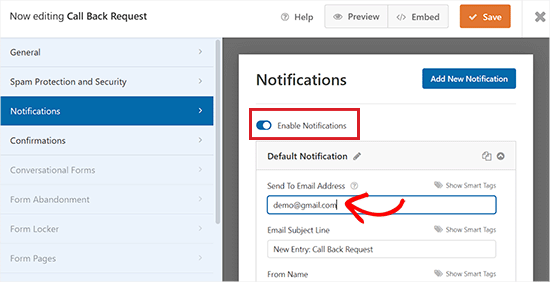
Once you have done that, you can easily change the email address where notifications get sent by typing a different email into the ‘Send To Email Address’ box.
You can also click on the ‘Add New Notification’ button to create your custom notifications.
This comes in handy when you also want to notify the user that you have received their callback request.
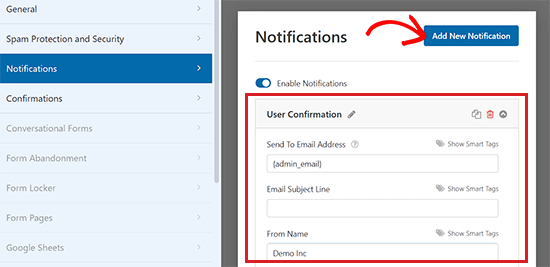
After clicking the ‘Add New Notifications’ button, WPForms will ask you to provide a name for the new notification and then show you the notification settings.
You can now click on the smart tags to enter the value submitted by the user in the form fields, like Name or Email.
You can also type an email body in the ‘Message’ section. For detailed instructions, you may want to see our beginner’s guide on how to send notifications to multiple recipients in WPForms.
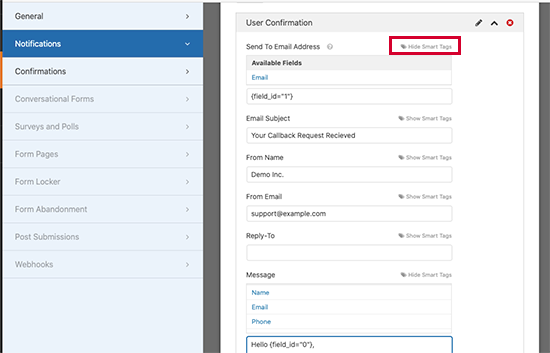
Once you are finished, don’t forget to click on the ‘Save’ button to store your form settings.
Customize the Form Submission Message for Visitors
You can also customize the form submission message that appears on the viewer’s screen after submitting the request to callback form.
When visitors enter their details and submit the form, a default message is displayed. You can change this to show a custom success message or redirect users to any post or page on your website.
To do this, simply switch to the ‘Confirmations’ tab from the form settings in the left column.
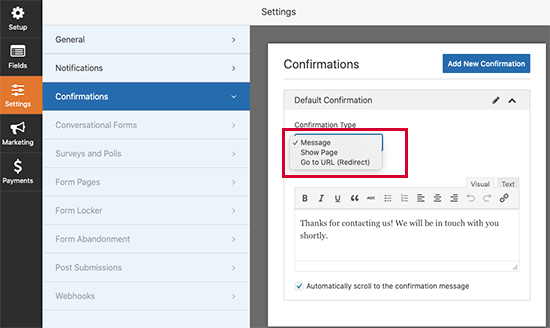
Next, you can choose what happens when a user submits the form under the ‘Confirmation Type’ dropdown menu.
If you choose the ‘Message’ option, then you will have to type a success message into the ‘Confirmation Message’ textbox.
However, on choosing the ‘Go to URL (Redirect)’ option, you can type the URL for the page that you want your users to be redirected to upon filling out the form.
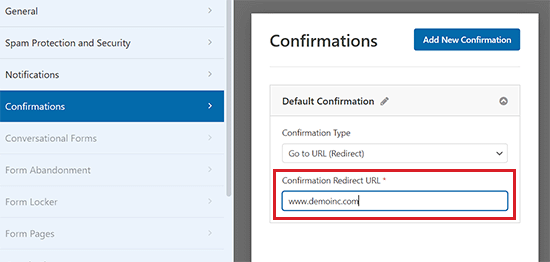
Once you are finished, don’t forget to click on the ‘Save’ button to store your settings.
You can now go ahead and test your form by filling it out. Based on your confirmation settings, WPForms will then show you the success message or redirect you.
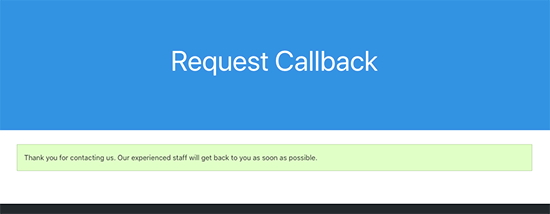
How to View ‘Request to Callback’ Form Submissions in WPForms
The best thing about using WPForms is that it automatically saves all the form submissions to your WordPress database.
This means you can easily view form entries even if you don’t receive email notifications.
To do this, visit the WPForms » Entries page from the WordPress admin area and click on the form you created earlier.

This will direct you to a new page, where you will see a list of entries submitted by your users along with their details.
From here, you can even organize your entries by using the star icon to highlight the important entries. You can also use the green circle to mark the entries as ‘Read’.
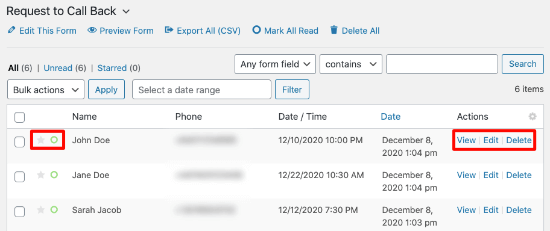
Next, you can view, edit, and delete the details of each entry as well by clicking the links in the right corner of the entry rows.
You can also add notes to individual form entries, which helps you keep track of leads and create notes for follow-up requests.
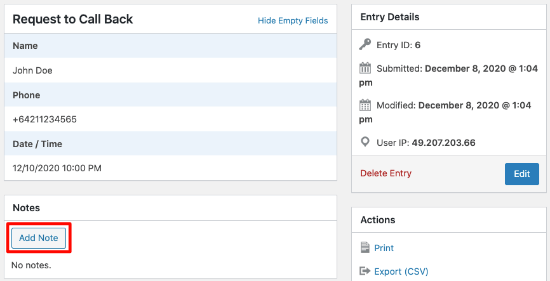
Promoting the Callback Request Form on Your Website
Now that you have created a callback request form for your website, you may want to promote it so that users can easily find and take advantage of this service.
This is where OptinMonster comes in. It is the best lead generation tool on the market that allows you to easily convert website visitors into leads and paying customers.
It also works well with WPForms and allows you to embed your forms into popups, slide-ins, fullscreen popups, and more.
For further instructions, please see our tutorial on how to create a contact form popup in WordPress.
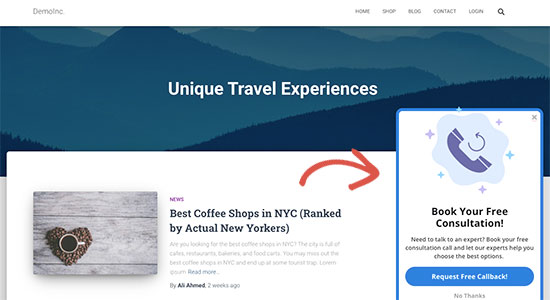
Moreover, OptinMonster comes with powerful display rules, which allow you to display the callback form to users when it is most effective, making it the best email capture plugin.
For example, you can only show a callback form to users in a specific region or country or when visitors are viewing a specific page on your site.
Bonus: Find a Reliable Business Phone Service
Once you have created a request to callback form, you will also need to find a reliable business phone service that can help enhance the user experience.
Many businesses use their landline or mobile numbers to conduct business and answer customer phone calls. However, this is not the most effective solution.
Conventional phone services lack advanced call management features, which are essential for businesses to offer a better customer experience.
This is why we use Nextiva in our business. They are the best business phone service provider on the market and allow you to manage your business calls using VoIP (Voice over Internet Protocol).
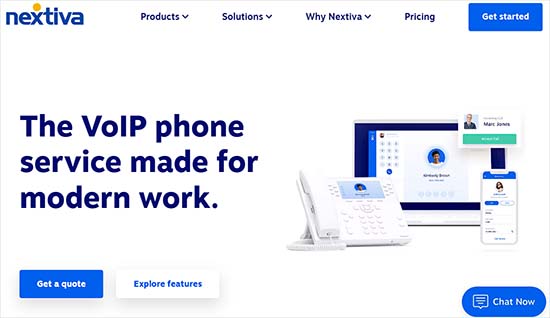
You can use it with any device, including your mobile phone, desk phone, laptop, or tablet. You can also choose the number from any region and share it with different team members. Nextiva also includes smart features such as call forwarding, voice messages, automated responses, ringtones, and more.
The voice quality is better, too, and it is way cheaper than traditional phone services.
We hope this article helped you learn how to easily add a request to callback form in WordPress. You may also want to see our guide on how to track the user journey on lead forms and our expert picks for the best business VoIP providers.
If you liked this article, then please subscribe to our YouTube Channel for WordPress video tutorials. You can also find us on Twitter and Facebook.





Syed Balkhi says
Hey WPBeginner readers,
Did you know you can win exciting prizes by commenting on WPBeginner?
Every month, our top blog commenters will win HUGE rewards, including premium WordPress plugin licenses and cash prizes.
You can get more details about the contest from here.
Start sharing your thoughts below to stand a chance to win!